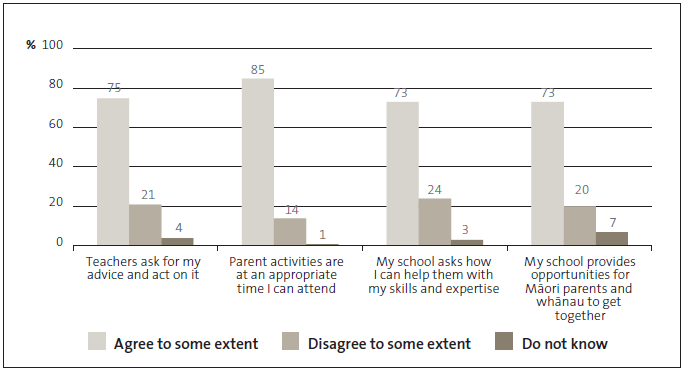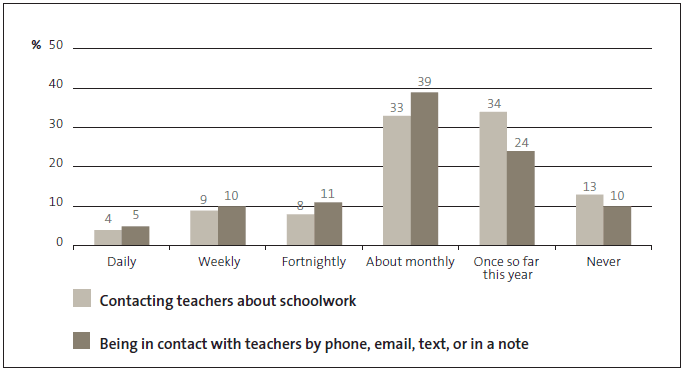Part 3: Students’ and whānau views on their relationships with schools
3.1
In this Part, we discuss students’ and whānau views on aspects of their relationships with schools.
Do whānau think relationships are effective?
3.2
We asked whānau whether they agreed with the statement “My child’s school has an effective relationship with its Maori students and whānau.” Sixty-six percent of whānau agreed that their child’s school has an effective relationship with its Māori students and whānau, and 78% of whānau agreed to some extent.
3.3
Whānau tended to rate low-decile schools and schools with a high proportion of Māori students more highly. Responses that agreed that they had an effective relationship with their school ranged from:
- 79% for low-decile schools;
- 55% for high-decile schools;
- 77% for schools with a high proportion of Māori students; and
- 59% for schools with a low proportion of Māori students.
3.4
We looked at a range of documents from the 600 schools in our sample. Except for policies on building relationships with whānau, we found little association between charters, targets, and reporting practices and whether whānau agreed that relationships were effective.
What students told us about their teachers
3.5
We asked students four questions about their teachers. From the sample responses:
- 90% of students agreed that teachers know who they are;
- 78% of students agreed to some extent that teachers knew them as a person and what they can contribute;
- 76% of students agreed that teachers listen to what students want to achieve; and
- 70% of students agreed that teachers value their Māori heritage.
3.6
Students in low-decile schools tended to rate their teachers more highly (results ranged from 81% to 94% for the four questions) than those in high-decile schools (results ranged from 59% to 86% for the four questions).
3.7
Students in schools with a high proportion of Māori students tended to rate their teachers more highly (results ranged from 80% to 92%) than those in schools with a low proportion of Māori students (results ranged from 62% to 87%).
Do whānau find it easy to get involved with their child’s school?
3.8
Figure 1 shows the proportion of whānau who agreed to some extent or disagreed to some extent with four questions about how easy it is for them to get involved with their child’s school. About three-quarters of whānau think that their schools make it easy to become involved in one way or another.
Figure 1
The proportion of whānau who find it easy to get involved with their child’s school

3.9
Whānau tended to rate low-decile schools and schools with a high proportion of Māori students more highly. Responses that agreed to some extent with the four questions ranged from:
- 79% to 86% for low-decile schools;
- 63% to 84% for high-decile schools;
- 79% to 87% for schools with a high proportion of Māori students; and
- 67% to 84% for schools with a low proportion of Māori students.
3.10
We asked whānau whether they liked to spend time at their child’s school – 86% of whānau agreed that they did.
3.11
We asked whānau whether they felt they could let teachers know about things that worry their child – 88% of whānau agreed that they could.
3.12
We wanted to know how often whānau contacted teachers about their child’s schoolwork and were in contact with teachers generally. Figure 2 shows the range of responses that we got. Most whānau were in contact with teachers about monthly or had been in contact once.
Figure 2
How often whānau and teachers were in contact
Do whānau think that schools keep them informed about their child?
3.13
We asked whānau whether their school kept them well informed, feeling confident and part of what their children are doing at school – 75% agreed.
3.14
The results were:
- 83% for low-decile schools;
- 71% for high-decile schools;
- 82% for schools with a high proportion of Māori students; and
- 71% for schools with a low proportion of Māori students.
3.15
We asked whānau whether the school provided clear information about student achievement, including Māori students’ achievement – 67% said yes, 20% said no, and 11% did not know.
3.16
Whānau with children at low-decile schools were 17% more likely to answer yes, and whānau with children at schools with a high proportion of Māori students were 13% more likely to say yes.
Are schools committed to Māori students succeeding as Māori?
3.17
We asked whānau whether they thought their child’s school was committed to Māori students succeeding as Māori. In total, 64% of whānau agreed. Figure 3 shows the responses we got.
Figure 3
Whether whānau think that their child’s school is committed to Māori students succeeding as Māori

3.18
Responses from whānau who agreed that their child’s school was committed to Māori students succeeding as Māori were:
- 79% for low-decile schools;
- 52% for high-decile schools;
- 76% for schools with a high proportion of Māori students; and
- 56% for schools with a low proportion of Māori students.
3.19
We asked whānau whether their child’s school changes things to improve outcomes for Māori students – 55% of whānau agreed that their school had.
3.20
The results were:
- 72% for low-decile schools and 42% for high-decile schools, which is a difference of 30%; and
- 69% for schools with a high proportion of Māori students and 44% for schools with a low proportion of Māori students, which is a difference of 25%.
3.21
We sorted the survey responses into two groups: those who agreed and those who agreed to some extent. Appendix 3 summarises the results for responses to questions by decile for students and whānau who agreed and agreed to some extent. Appendix 4 summarises the results for responses to questions 1-14 by the school’s proportion of Māori students for students and whānau who agreed and agreed to some extent.
3.22
Appendix 3 shows the parts of the relationship that whānau from these schools rated the lowest. These low ratings indicate that these schools could ask the advice of whānau, ask whānau about how they can help the school with their skills and expertise, provide more opportunities for whānau to get together, change things to improve outcomes for Māori students,14 and show more commitment to Māori students succeeding as Māori.
3.23
With only a few exceptions, the survey results for middle-decile schools to each question in our survey tended to be between the responses for low-decile schools and those for high-decile schools.
Our observations
3.24
When we discussed our findings with our Māori Advisory and Reference Group, we agreed that there were some encouraging results.
3.25
Whānau with students in low-decile schools and in schools with a high proportion of Māori students tended to rate their schools more highly. This suggests that many of these schools have basic connections with whānau and students.
3.26
In contrast, high-decile schools and schools with a low proportion of Māori students tended to be rated lower by students and whānau. Some of these schools have more work to do to improve their relationships with students and whānau.
14: Ka Hikitia suggests that some things schools could change are: integrating elements of Māori student identity, language, and culture; using student achievement data to better target resources; providing early, intensive support to students at risk of falling behind; creating better partnerships with parents, whānau, and iwi; and having high expectations of students to succeed.


